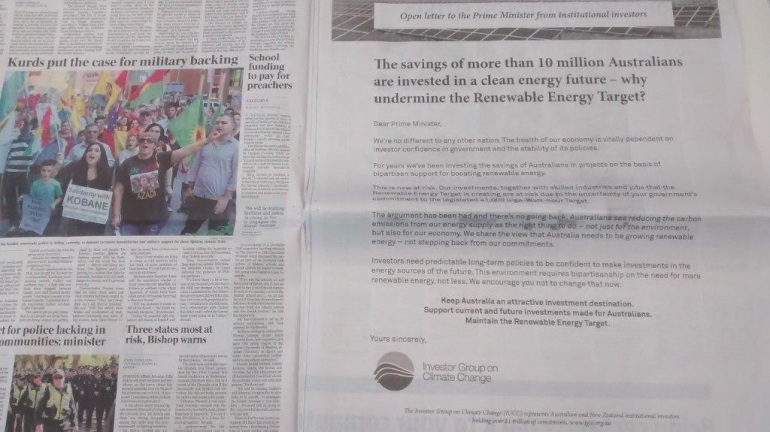Energy agency's warning to government on RET
The International Energy Agency (IEA) released a technology roadmap for solar photovoltaics (solar PV) and solar thermal (STE) power generation yesterday which envisages a scenario where solar could become the largest source of power globally by 2050.
But in outlining this optimistic scenario, where solar provides power cheaper than what we can obtain from coal today, it also issues a warning of direct relevance to the current Australian debate over the Renewable Energy Target. To get power that is cheap as well as clean requires a regulatory environment that provides clear and stable long-term goals that support investor confidence.
Meanwhile, today the key representative group for institutional investors in such technologies, the Investor Group on Climate Change, has taken out full-page advertisements (below) across Australian newspapers warning Prime Minister Tony Abbott that he is doing precisely the opposite.

Source: The Australian newspaper – Tuesday, September 30
This IEA analysis suggests that it would be feasible for the globe to get 16 per cent of its power from solar PV and 11 per cent from solar thermal if governments were to seek to contain global warming to around 2 degrees. The bar on the far right of the chart below illustrates the envisaged global electricity fuel mix under this scenario, where solar becomes the largest source of power (illustrated in the two orange shades). By comparison, the far left chart illustrates the fuel mix in 2011 where solar doesn’t even register. Also, the chart second from the left is the fuel mix we’ll end up with in 2050 if governments don’t act to contain global warming – consigning us to a catastrophic 6-degree warmer world.
Figure 1: Global electricity generation fuel mix – 2011 versus 2050 under business as usual with 6 degrees of warming (6DS) versus 2 degrees (2DS & hi-Ren)
Source: International Energy Agency (2014) Technology Roadmap Solar Photovoltaic Energy
The two tables below outline a trajectory for how the cost of solar PV power could decline over time. The International Energy Agency believes this is possible with foreseeable technological improvements and learning by doing, and provided the perceived financing risk for solar is brought into line with other power technologies (enabling a real 8 per cent financing cost). By comparison, the government’s Bureau of Resources and Energy Economics estimates that the cost of power from a new-build coal power station (assuming away the carbon price financing risk attached to such a project) in Australia would be between $60 to $100 per megawatt-hour and for a gas power plant (CCGT) would be $70 to $130 per MWh.
Figure 2: Utility-scale solar PV – cost of electricity over time (USD/MWh)

Figure 3: Rooftop solar PV – cost of electricity over time (USD/MWh)

Note: All levelised cost of electricity calculations in these tables rest on a real 8 per cent weighted average cost of capital.
Source: International Energy Agency (2014) Technology Roadmap Solar Photovoltaic Energy
It’s worth noting that the Australian Renewable Energy Agency already believes Australian utility-scale solar PV projects could achieve costs below the 2020 average projected by the IEA, if financing costs were 8 per cent. In addition, Australian retailers of rooftop solar systems are already achieving costs similar to the average the IEA is projecting for 2020.
The IEA also see solar thermal power with six hours of energy storage being able to achieve similar costs to utility-scale solar PV, as detailed in the table below.
Figure 4: Solar thermal with 6 hours storage – cost of electricity over time (USD/MWh)

Note: All levelised cost of electricity calculations in this table rest on a real 8 per cent weighted average cost of capital
Source: International Energy Agency (2014) Technology Roadmap Solar Thermal Electricity
This latest report from the International Energy Agency adds to an accumulating body of expert opinion (including that of BREE) which suggests that renewable energy technologies could provide power at costs in the future not all that different to that from fossil fuels.
However, this won’t happen without serious investment by the private sector in deploying these technologies to gain experience and undertaking further research and development.
With Labor entering into negotiations with the Coalition Government this week over the future shape of the RET, the politicians need to keep in mind the following advice given by the IEA’s executive director, Maria van der Hoeven:
“...where there is a record of policy incoherence, confusing signals or stop-and-go policy cycles, investors end up paying more for their investment, consumers pay more for their energy, and some projects that are needed simply will not go ahead.”
This has been echoed by the Investor Group on Climate Change, which represents a large number of some of Australia’s largest superannuation funds and other institutional investors with over $1 trillion of funds under management. Their open letter to the Prime Minister notes:
Investors need predictable long-term policies to be confident to make investments in the energy sources of the future. This environment requires bipartisanship on the need for more renewable energy, not less. We encourage you not to change that now.

















